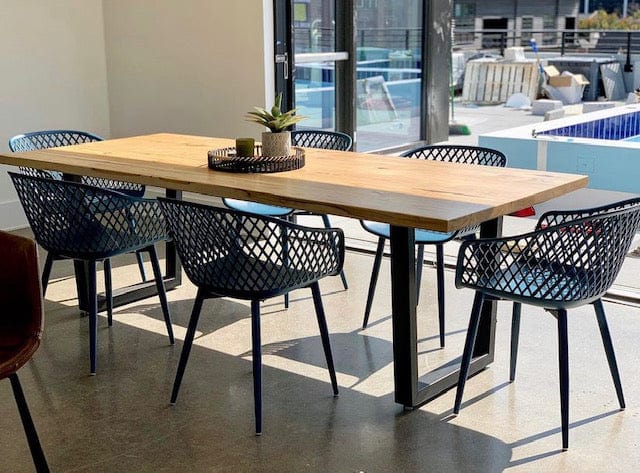Upgrade Your Furnishings with Trendy Dining Room Table Legs
Upgrade Your Furnishings with Trendy Dining Room Table Legs
Blog Article
An In-depth Look at Dining Table Leg Styles: Finding the Perfect Match
Selecting the right table leg style is essential for both aesthetic allure and functional functionality. Traditional four legs offer classic sophistication and stability, while the stand base supplies increased legroom and a modern-day look. For those with larger tables, trestle legs make certain durable support, whereas barrette legs introduce a mid-century modern-day vibe with their minimal style. The x-shaped legs mix contemporary design with improved security. Each of these choices brings unique advantages, making the selection greater than simply a matter of choice. Check out better to find which design flawlessly enhances your eating room and lifestyle.
Typical 4 Legs
Amongst the numerous kinds of table leg styles, the traditional four-leg style remains a classic choice for several houses. This classic arrangement uses a harmonious blend of performance and aesthetics, making it a seasonal favorite. Four legs provide well balanced assistance, making sure the table stays stable and efficient in birthing considerable weight. This is specifically useful for households that frequently host huge gatherings or use their eating table for several functions, such as job or crafting.
From an aesthetic point of view, the typical four-leg design can be easily adjusted to numerous indoor styles. Whether crafted from wood, steel, or a combination of products, these legs can be elaborately carved, smooth and minimalistic, or anything in between. Their convenience enables them to complement both rustic and modern setups seamlessly.
In addition, the straightforward framework of the four-leg layout facilitates ease of movement and positioning within a room. Unlike even more facility bases, this design reduces blockages, offering ample legroom for restaurants. In recap, the traditional four-leg dining table leg design weds enduring elegance with sensible capability, making it a sharp choice for those seeking both form and feature in their dining furnishings.
Stand Base
Typically commemorated for its classy and space-efficient design, the pedestal base is a distinguished option to the conventional four-leg setup in dining table leg styles. This distinctive base generally features a solitary main column sustaining the tabletop, which can differ in form, from ornately sculpted timber to sleek, modern-day metal. One of the main benefits of the pedestal base is its capability to make best use of legroom and seating flexibility. Without corner legs, restaurants are afforded higher liberty of activity, making it an optimal selection for round and oval tables that promote more intimate and comprehensive celebrations.
The main column itself provides a canvas for intricate layouts and creative expressions, adding a component of aesthetic interest under the table. In recap, the pedestal base incorporates performance with design, making it a fine-tuned and useful alternative for diverse pop over here eating atmospheres.
Trestle Legs
Trestle legs provide a durable and ageless structure for dining tables, identified by their horizontal cross-bracing and sturdy assistance beams. Stemming from medieval times, this style has progressed yet retained its crucial structure, making it a seasonal favorite in both typical and contemporary setups. The central trestle beam, often sustained by two or even more vertical articles, uses remarkable stability, permitting bigger table sizes without the need for additional legs.
A substantial benefit of trestle leg tables is the adequate legroom they offer. Unlike tables with four edge legs, the absence of obstructions at the table's sides provides unobstructed room for chairs and diners, improving convenience and ease of access. This makes trestle tables excellent for accommodating larger celebrations, whether in a dining room or a banquet hall.
The visual versatility of trestle legs is notable. Offered in a selection of products such as wood, metal, and composite, they can be completed to enhance a wide variety of interior designs. From rustic farmhouse to smooth contemporary designs, trestle legs can be customized to match individual preferences. Their enduring appeal and practical advantages make trestle legs an engaging selection for those her comment is here looking for both design and practicality in their table.
Hairpin Legs

The appeal of barrette legs depends on their simplicity and adaptability - dining room table legs. Readily available in a variety of products, including steel and brass, they redirected here can be finished in various shades to complement various interior styles. Whether paired with a rustic wood tabletop or a modern glass surface area, hairpin legs easily blend capability with a touch of classic charm
Longevity is an additional notable attribute of barrette legs. In spite of their delicate appearance, these legs are engineered to bear substantial weight, guaranteeing the dining table stays stable and safe. Additionally, they are relatively simple to set up, making them a preferred option for do it yourself enthusiasts and professional furniture manufacturers alike.
X-Shaped Legs

Constructed from materials such as steel, timber, or a mix of both, X-shaped legs can be tailored to match various design preferences. Steel legs usually offer a smooth and industrial feeling, perfect for loft-style homes and modern dining spaces. On the other hand, wooden X-shaped legs use a warmer, a lot more rustic charm, ideal for farmhouse or eclectic interiors. The convenience in materials permits home owners to customize their eating tables to much better fit their overall style scheme.
Furthermore, the engineering behind X-shaped legs guarantees also weight distribution, decreasing the threat of tottering and improving longevity. This makes them particularly appropriate for bigger table that call for extra assistance. Basically, X-shaped legs blend practical engineering with modern looks, making them a timeless choice for diverse eating environments.
Final Thought
A detailed understanding of dining table leg styles exposes the distinct attributes and benefits of each layout. Trestle legs make certain robust assistance for bigger tables, and hairpin legs introduce a mid-century modern aesthetic.
Report this page